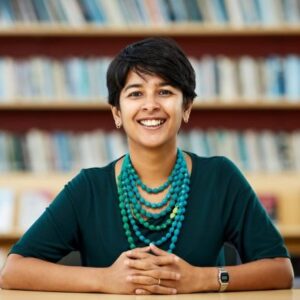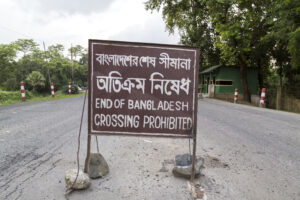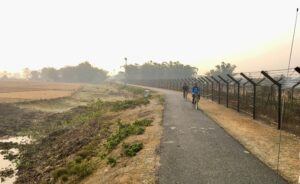SAHANA GHOSH
 Assistant Professor Sahana Ghosh (NUS Department of Sociology and Anthropology) was recently granted the FASS Award for Promising Researcher (APR). This award is presented to researchers who have produced research that shows potential impact and promise.
Assistant Professor Sahana Ghosh (NUS Department of Sociology and Anthropology) was recently granted the FASS Award for Promising Researcher (APR). This award is presented to researchers who have produced research that shows potential impact and promise.
Dr Ghosh received her PhD in Sociocultural Anthropology and Women’s, Gender and Sexuality Studies from Yale University. Her primary research interests are borders and borderlands, mobility, gender and sexuality, critical security studies, ethnography of the state, transnational and postcolonial feminism, South Asia, space and value, labor studies, and feminist and decolonial pedagogy. She is currently researching the gendered labors of soldiering in India and the transnational governance of labor migration through the prism of Bangladesh.

Dr Ghosh’s research and photo essays have appeared in many highly ranked journals including American Anthropologist, Current Anthropology, Comparative Studies of South Asia, Africa, and the Middle East, Economic and Political Weekly, and Gender, Place and Culture. Her first book, A Thousand Tiny Cuts: Mobility and Security Across the India-Bangladesh Borderlands (University of California Press, 2023), chronicles the slow transformation of a connected region into national borderlands and shows the foundational place of gender and sexuality in the meaning and management of threat and security in relation to mobility. It recasts a singular focus on border fences and migrants as border-crossers and shows, instead, that postcolonial bordering materializes through multiple forms of violence and devaluation in agrarian, borderland lives. Informed by two and a half years of fieldwork in the borderlands of northern Bangladesh and eastern India, A Thousand Tiny Cuts received the Sardar Patel Dissertation Award for best thesis on South Asia in any discipline at any North American University.
We congratulated Dr Ghosh and spoke to her about her research work.
1. What inspired you to become a social anthropologist?
I like people and stories! I went from being a student of literature interested in social justice to realizing that something called ethnography would allow me to engage real people and their real life experiences to understand the complexity of social and political issues. That is what led me to and converted me to social anthropology and especially ethnography.
2. How did you initially become interested in studying transnational mobility?

It was a class in diaspora literatures during my MA in English Literature in India that really got me interested in transnational mobility – how people experience social and cultural change, difference, and how they feel and express identity and belonging. I was particularly drawn to family as a site of power and fractured social-political relations and identities. As I mentioned, these interests led me from literary texts to real people’s stories and experiences. Social anthropology gave me the tools and the language to explore these topics. It also helped me better understand my own family’s history of transnational mobility and displacement from Burma to India during the Second World War. During this MA and later during an MPhil in Migration Studies at the University of Oxford, I began to see how family histories and ordinary people’s life histories of mobility and belonging – like that of my grandmother for example – reflect and participate in extraordinary political and historical processes.
3. What were some of the challenges you encountered while doing fieldwork in the borderlands of northern Bangladesh and eastern India for your forthcoming book, A Thousand Tiny Cuts?

Perhaps the most consistent challenge while conducting fieldwork in the borderlands was navigating surveillance and suspicion from the Indian and Bangladesh security institutions, especially as a lone, young woman. Despite having reams of research permissions, affiliations with regional universities, and being in contact with local governmental authorities, I faced obstructions in both countries. While it was hard and sometimes scary, I also received great kindness and developed deep friendships. It also taught me first-hand what borderland residents deal with on a daily basis; citizenship does not afford equal privileges and protections. These challenges became part of my research and efforts to build transnational solidarity. Many of these challenges – and privileges – were specific to gender, class, and nationality, and as a scholar and teacher I emphasize that these material conditions of research and knowledge production are central and not simply background.
4. To what extent do you think your research studies on agrarian borderlands could be applied to borderlands in geographical areas that are more urban and industrialized?

There are several questions that my research on agrarian borderlands in South Asia raises that are more broadly relevant for understanding borderlands in any region. To begin with, to examine empirically what being and becoming a borderland means in any given place. Often, borderlands are assumed to be just there, where there is an international border. Investigating what a borderland means from legal, regulatory terms to experiential terms, shows that gender, class, and sexuality are foundational to making marginality of both spaces and people. Studying how people who live and work in borderlands understand their positions and their socioeconomic worlds can reveal perspectives often neglected or undermined from centers of power – this has enormous consequences for law, economy, and citizenship. Second, my research shows the importance of taking a relational approach – whether to the study of cross-border kinship or mobility, agrarian commerce, and labor. Such an approach pushes research on these topics to go beyond methodological nationalism.
5. Which of your academic publications are you most proud of and why?
 My first academic publication from my doctoral research (2017) was in the Economic and Political Weekly, an Indian journal that is widely read beyond academia. I received messages from retired bureaucrats, journalists, and families that had identified with the stories of transnational marriages across the India-Bangladesh borderlands that I had discussed in the article. A film-maker was inspired by the article and used it as a source in his documentary film on India’s borderlands which has been widely acclaimed. The other academic publication I am proud of is a recently published photographic essay in Current Anthropology (2022), one of the top anthropology journals. It creatively engages questions of violence and militarization at borders in our contemporary world, asking us to look beyond spectacular structures like walls and fences. I am hopeful that this will be a useful teaching resource for colleagues and students interested in these topics across the world.
My first academic publication from my doctoral research (2017) was in the Economic and Political Weekly, an Indian journal that is widely read beyond academia. I received messages from retired bureaucrats, journalists, and families that had identified with the stories of transnational marriages across the India-Bangladesh borderlands that I had discussed in the article. A film-maker was inspired by the article and used it as a source in his documentary film on India’s borderlands which has been widely acclaimed. The other academic publication I am proud of is a recently published photographic essay in Current Anthropology (2022), one of the top anthropology journals. It creatively engages questions of violence and militarization at borders in our contemporary world, asking us to look beyond spectacular structures like walls and fences. I am hopeful that this will be a useful teaching resource for colleagues and students interested in these topics across the world.
6. What has been your most memorable teaching experience at NUS?
Teaching a class on ethnographic methods to first year students enrolled in the new undergraduate major in anthropology. It is fabulous, rewarding, and great fun! Watching students try out and see for themselves the enormous power and sharp insights that come from ethnographic methods – participant observation, working with objects, recording family histories, sketching or mapping spaces, working with sounds and images – as they explored their individual research topics over the course of the semester. Students discovered talents as well as limitations, deepened existing interests or became curious about new ones and worked on really exciting projects. It was a joy to introduce ethnographic ways of seeing and knowing and I look forward to more creative collaboration with students in and around the classroom.
7. Lastly, what research avenues are you keen on pursuing in future?

I am currently at work on a historical ethnography of soldiering in postcolonial India. It extends my interests and expertise on gender, security, and the postcolonial state to questions of military labor. I am taking a new methodological approach in combining archival research, memoirs and literary texts, with interviews and extensive life histories of soldiers and officers. I am keen to bring together different kinds of image-making practices – personal photographs held by families with official social media posts, Bollywood filmic depictions with newspaper reportage – that nuance our understandings of the work of soldiering, how it is gendered and valued in institutional and social terms.
Thank you very much for taking the time to answer these questions, Dr Ghosh! And congratulations again on being awarded Promising Researcher!

